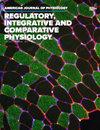成年雄性 Wistar 大鼠通过 Roux-en-Y 胃旁路手术减轻体重的主要原因是热量摄入减少和手术前体重增加。
IF 2.2
3区 医学
Q3 PHYSIOLOGY
American journal of physiology. Regulatory, integrative and comparative physiology
Pub Date : 2024-04-08
DOI:10.1152/ajpregu.00169.2023
引用次数: 0
摘要
不同宏量营养素组成、能量密度和/或适口性的饮食可能会导致减肥手术结果的差异。在本研究中,喂食健康低脂饮食(LF)或致肥高脂/蔗糖饮食(HF/S)的大鼠均接受了鲁氏胃旁路手术(RYGB)或假手术,并对体重下降轨迹和各种能量平衡参数进行了评估。在 RYGB 之前,与食用低脂饮食(n=20;p<0.01)的大鼠相比,食用高脂/低脂饮食(n=14)的大鼠体重有所增加。RYGB 术后,HF/S(6 只)大鼠的绝对体重减轻幅度大于 LF 饲喂(6 只)大鼠,这与累积能量摄入减少(EI;p<0.05)和运动活动增加(LA;p<0.05-0.001)有关,最终导致术后 3 周 HF/S 和 LF 大鼠体内脂肪含量的减少水平相似。回归分析表明,RYGB 诱导的体重减轻的变化可通过以下模型得到最好的解释:a)手术后累积 EI 和手术前体重(R2=0.87);b)手术后累积 EI 和饮食(R2=0.79),每个模型都没有 LA 的显著贡献。特别是,与喂食 HF/S 的大鼠相比,喂食 LF 的大鼠在 RYGB 术后会出现短暂的体温过低和昼夜节律失常(即手术相关乏力的指标)。我们的数据表明,相对于饲喂低脂饮食,继续饲喂 HF/S 饮食不会对 RYGB 手术后的恢复产生负面影响,但它会促进 RYGB 引起的体重减轻,这主要是由于累积 EI 减少和手术前体重增加,最终导致 HF/S 和低脂饮食大鼠体内脂肪含量水平相当低。本文章由计算机程序翻译,如有差异,请以英文原文为准。
Weight loss in adult male Wistar rats by Roux-en-Y gastric bypass is primarily explained by caloric intake reduction and pre-surgery body weight.
Diets varying in macronutrient composition, energy density, and/or palatability may cause differences in outcome of bariatric surgery. In the present study, rats feeding a healthy low fat (LF) diet or an obesogenic high fat/sucrose diet (HF/S) were either subjected to Roux-en-Y gastric bypass surgery (RYGB) or sham surgery, and weight loss trajectories and various energy balance parameters were assessed. Before RYGB, rats eating a HF/S (n=14) diet increased body weight relative to rats eating a LF diet (n=20; p<0.01). After RYGB, absolute weight loss was larger in HF/S (n=6) relative to LF feeding (n=6) rats, and this was associated with reduced cumulative energy intake (EI; p<0.05) and increased locomotor activity (LA; p<0.05-0.001), finally leading to similar levels of reduced body fat content in HF/S and LF rats 3 weeks after surgery. Regression analysis revealed that variation in RYGB-induced body weight loss was best explained by models including a) post-surgery cumulative EI and pre-surgery body weight (R2=0.87) and b) post-surgery cumulative EI and diet (R2=0.79), each without significant contribution of LA. Particularly rats on the LF diet became transiently more hypothermic and circadianally arrhythmic following RYGB (i.e., indicators of surgery-associated malaise) than HF/S feeding rats. Our data suggest that relative to feeding a LF diet, continued feeding a HF/S diet does not negatively impact recovery from RYGB surgery, yet it promotes RYGB-induced weight loss explained primarily by reduced cumulative EI and higher pre-surgery body weight, finally leading to comparably low levels of body fat content in HF/S and LF feeding rats.
求助全文
通过发布文献求助,成功后即可免费获取论文全文。
去求助
来源期刊
CiteScore
5.30
自引率
3.60%
发文量
145
审稿时长
2 months
期刊介绍:
The American Journal of Physiology-Regulatory, Integrative and Comparative Physiology publishes original investigations that illuminate normal or abnormal regulation and integration of physiological mechanisms at all levels of biological organization, ranging from molecules to humans, including clinical investigations. Major areas of emphasis include regulation in genetically modified animals; model organisms; development and tissue plasticity; neurohumoral control of circulation and hypertension; local control of circulation; cardiac and renal integration; thirst and volume, electrolyte homeostasis; glucose homeostasis and energy balance; appetite and obesity; inflammation and cytokines; integrative physiology of pregnancy-parturition-lactation; and thermoregulation and adaptations to exercise and environmental stress.

 求助内容:
求助内容: 应助结果提醒方式:
应助结果提醒方式:


